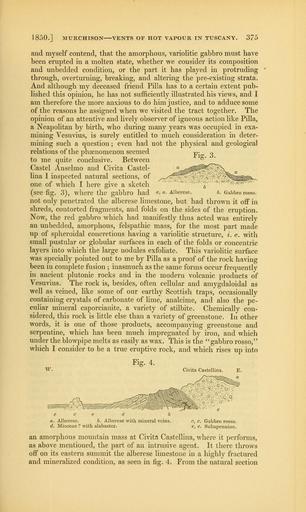MAKE A MEME
View Large Image

| View Original: | The_Quarterly_journal_of_the_Geological_Society_of_London_(13365415485).jpg (1239x2073) | |||
| Download: | Original | Medium | Small | Thumb |
| Courtesy of: | commons.wikimedia.org | More Like This | ||
| Keywords: The Quarterly journal of the Geological Society of London (13365415485).jpg 1850 MURCHISON VENTS OF HOT VAPOUR IN TUSCANY 375 <br> and myself contend that the amorphous variohtie gabbro must have <br> been erupted in a molten state whether we consider its composition <br> and unbedded condition or the part it has played in protruding <br> through overturning breaking and altering the pre-existing strata <br> And although my deceased friend Pilla has to a certain extent pub- <br> lished this opinion he has not sufficiently illustrated his views and I <br> am therefore the more anxious to do him justice and to adduce some <br> of the reasons he assigned when we visited the tract together The <br> opinion of an attentive and lively observer of igneous action like Pilla <br> a Neapolitan by birth who during many years was occupied in exa- <br> mining Vesuvius is surely entitled to much consideration in deter- <br> mining such a question ; even had not the physical and geological <br> relations of the phsenomenon seemed p o <br> to me quite conclusive Between °' <br> Castel Anselmo and Civita Castel- <br> lina 1 inspected natural sections of <br> one of which I here give a sketch <br> see fig 3 where the gabbro had a « Alberese b Gabbro rosso <br> not only penetrated the alberese limestone but had thrown it off in <br> shreds contorted fragments and folds on the sides of the eruption <br> Now the red gabbro which had manifestly thus acted was entirely <br> an unbedded amorphous felspathic mass for the most part made <br> up of spheroidal concretions having a variolitic structure i e with <br> small pustular or globular surfaces in each of the folds or concentric <br> layers into which the large nodules exfoliate This variolitic surface <br> was specially pointed out to me by Pilla as a proof of the rock having <br> been in complete fusion ; inasmuch as the same forms occur frequently <br> in ancient plutonic rocks and in the modern volcanic products of <br> Vesuvius The rock is besides often cellular and amygdaloidal as <br> well as veined like some of our earthy Scottish traps occasionally <br> containing crystals of carbonate of lime analcime and also the pe- <br> culiar mineral caporcianite a variety of stilbite Chemically con- <br> sidered this rock is little else than a variety of greenstone In other <br> words it is one of those products accompanying greenstone and <br> serpentine which has been much impregnated by iron and which <br> under the blowpipe melts as easily as wax This is the 'gabbro rosso <br> which I consider to be a true eruptive rock and which rises up into <br> Fig 4 <br> W Civita Castellina E <br> e c e II <br> a Alberese b Alberese with mineral veins n e Gabbro rosso <br> d Miocene with alabaster e e Subapennine <br> an amorphous mountain mass at Civita Castellina where it performs <br> as above mentioned the part of an intrusive agent It there throws <br> off on its eastern summit the alberese limestone in a highly fractured <br> and mineralized condition as seen in fig 4 From the natural section 36934244 113689 51125 Page 375 Text v 6 http //www biodiversitylibrary org/page/36934244 1850 Geological Society of London NameFound Castellina NameFound Pilla NameConfirmed Pilla NameBankID 4574946 NameFound Vesuvius Biodiversity Heritage Library The Quarterly journal of the Geological Society of London v 6 1850 Geology Periodicals Smithsonian Libraries bhl page 36934244 dc identifier http //biodiversitylibrary org/page/36934244 smithsonian libraries Information field Flickr posted date ISOdate 2014-03-23 Check categories 2015 August 26 CC-BY-2 0 BioDivLibrary https //flickr com/photos/61021753 N02/13365415485 2015-08-26 10 55 23 cc-by-2 0 PD-old-70-1923 The Quarterly journal of the Geological Society of London 1850 Photos uploaded from Flickr by Fæ using a script | ||||